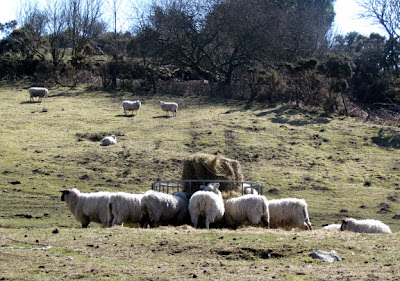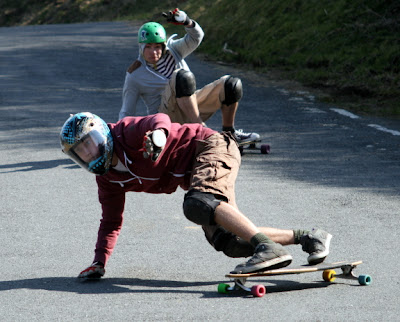It’s been odd this last few days
having breakfast without the group of friends that have been my
companions for the last year. They didn’t all arrive together: one
or two to begin with, then a few more showed up and – only a month
or so ago – a late arrival, very exciting – who had to be
introduced to the others, adjustments made, fresh ideas explored. And
all the while it was high summer in a secret valley at the edge of
the moor.
 |
| Swallows in full gossip |
Quite a shock then, to find them gone,
the kitchen empty, and the ash trees still in very tight black bud.
While I was living in my parallel universe – watching the swallows,
smelling new cut hay and honeysuckle, listening to skylarks – the
winter has loosened its grip a little, tulips are opening in the
garden, and the crab-apple tree is in blossom. Sun pours in through
the skylight window while I eat my breakfast and there is clear blue
sky beyond Brent Hill. I miss my friends: I miss wondering about
them, listening to scraps of conversations, making connections. I see
them in their own kitchens, in their cars, shopping, sailing. I
eavesdrop on them, snoop around their houses, study their gardens,
get to know their dogs. They can’t get away from me – and I can’t
get away from them!
 |
| Honeysuckle |
There is a degree of relief once their
stories are told and they begin to disappear back into their separate
world. I don’t let them go too quickly and I spend considerable
time wondering if I’ve listened properly, done them justice.
Sometimes my agent or my editor will ask for more information and
then I need to re-visit them, to listen again for something I might
have missed that could be expanded.
 |
| The River Tamar near Cotehele |
They never quite disappear, of course.
On Wednesday I drove across Dartmoor to Gunnislake to take an old
friend down to Cotehele for lunch. As I stood on the banks of the
Tamar, watching the tide rolling in across the mudflats, I was aware
of Johnny and Sophie and Oliver just around the bend in the river
and, driving back through Tavistock, I think I saw Kate hurrying into
The Bedford.
 |
| The quarry at Merrivale on Dartmoor. |
There was thick fog on the moor and I drove slowly,
thinking of Polly up behind Merrivale, and of Frances setting out for
Ashburton in the snow. I passed Foxhole and raised a hand to Brigid;
stopped to revel at the sight of the wood anemones in Hembury woods
that Louise saw on her way to Foxhole from the station.
 |
| Wood Anemones |
And, even as I’m writing this,
another old friend is standing at my shoulder, trying to grab my
attention. She’s been around for a few books now but each time
other characters and their stories have been more vociferous, clearer
to me. She’s moved in very close this time, though, and I think I’m
going to have to let her tell me her story; what she’s been doing
since I saw her last. I shall meet her new family and her friends and
discover the connections that link them together.
I was going to have a break; do all
those really crucial things that have been put on hold: gardening;
cleaning out cupboards; writing letters. Instead I’ll jut have to
make some coffee, sit in the sunshine on the balcony all amongst the
crab-apple blossom, and start listening. Gosh, it’s hell, being a
writer.
This week's blog dog is known as Skye.




























